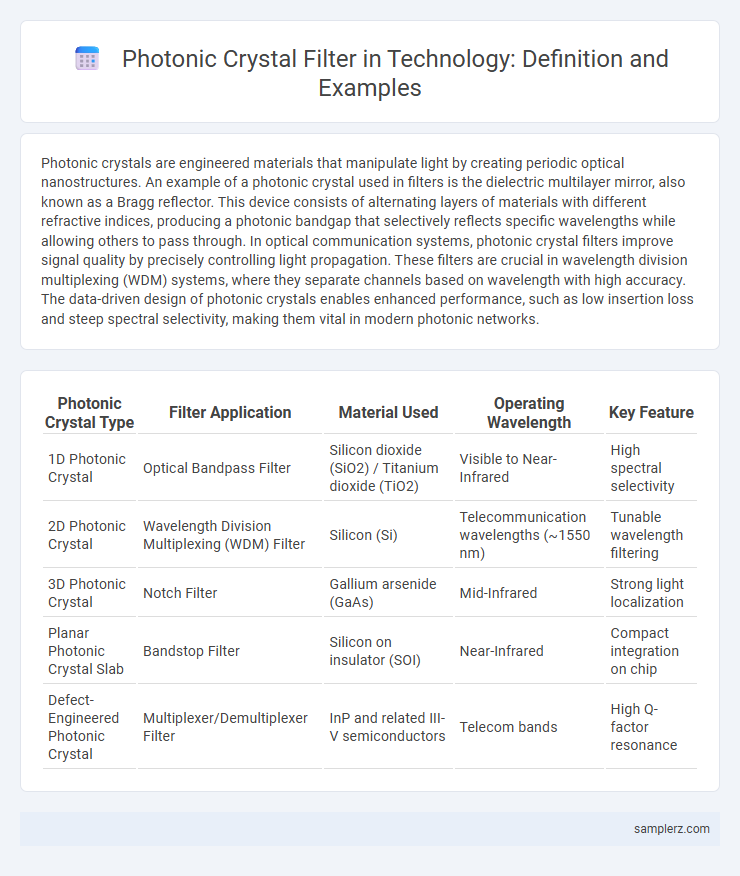Photonic crystals are engineered materials that manipulate light by creating periodic optical nanostructures. An example of a photonic crystal used in filters is the dielectric multilayer mirror, also known as a Bragg reflector. This device consists of alternating layers of materials with different refractive indices, producing a photonic bandgap that selectively reflects specific wavelengths while allowing others to pass through. In optical communication systems, photonic crystal filters improve signal quality by precisely controlling light propagation. These filters are crucial in wavelength division multiplexing (WDM) systems, where they separate channels based on wavelength with high accuracy. The data-driven design of photonic crystals enables enhanced performance, such as low insertion loss and steep spectral selectivity, making them vital in modern photonic networks.
Table of Comparison
| Photonic Crystal Type | Filter Application | Material Used | Operating Wavelength | Key Feature |
|---|---|---|---|---|
| 1D Photonic Crystal | Optical Bandpass Filter | Silicon dioxide (SiO2) / Titanium dioxide (TiO2) | Visible to Near-Infrared | High spectral selectivity |
| 2D Photonic Crystal | Wavelength Division Multiplexing (WDM) Filter | Silicon (Si) | Telecommunication wavelengths (~1550 nm) | Tunable wavelength filtering |
| 3D Photonic Crystal | Notch Filter | Gallium arsenide (GaAs) | Mid-Infrared | Strong light localization |
| Planar Photonic Crystal Slab | Bandstop Filter | Silicon on insulator (SOI) | Near-Infrared | Compact integration on chip |
| Defect-Engineered Photonic Crystal | Multiplexer/Demultiplexer Filter | InP and related III-V semiconductors | Telecom bands | High Q-factor resonance |
Introduction to Photonic Crystal Filters
Photonic crystal filters manipulate light by exploiting periodic dielectric structures that create photonic bandgaps, selectively blocking or transmitting specific wavelengths. These filters improve optical communication systems by enabling precise wavelength selectivity, high transmission efficiency, and compact integration in devices such as fiber optic networks. Applications include wavelength division multiplexing (WDM) and on-chip signal processing, demonstrating significant advancements in photonic crystal-based filter technology.
Key Principles of Photonic Crystal Filtering
Photonic crystal filters operate by exploiting the periodic dielectric structure to create photonic band gaps that selectively block or transmit specific wavelengths of light. These filters achieve high spectral selectivity and minimal insertion loss by manipulating the photonic band structure, enabling precise control of light propagation. Key principles include defect engineering within the photonic crystal lattice to localize modes and fine-tune the filtering characteristics for applications in optical communications and sensing.
One-Dimensional Photonic Crystal Filters
One-dimensional photonic crystal filters utilize alternating layers of materials with different refractive indices to create a periodic structure that selectively reflects specific wavelengths of light. This engineered periodicity results in a photonic bandgap, enabling precise filtering of optical signals in fiber optic communication and sensor applications. Such filters offer high spectral resolution and low insertion loss, making them crucial in wavelength division multiplexing (WDM) systems.
Two-Dimensional Photonic Crystal Waveguide Filters
Two-dimensional photonic crystal waveguide filters utilize periodic dielectric structures to precisely control light propagation within integrated optical circuits. These filters achieve high spectral selectivity and compact size by creating photonic bandgaps that block unwanted wavelengths while allowing desired signals to pass through engineered defects in the lattice. Applications in optical communication systems benefit from their low loss, tunability, and ability to integrate seamlessly with silicon photonics platforms.
Tunable Photonic Crystal Filters in Optical Networks
Tunable photonic crystal filters are essential components in optical networks, enabling dynamic wavelength selection with high precision and low insertion loss. These filters utilize periodic dielectric structures to control light propagation, allowing adjustable bandwidth and central wavelength tuning through external stimuli such as temperature, electric fields, or mechanical strain. Their integration improves channel routing, enhances network flexibility, and supports dense wavelength division multiplexing (DWDM) systems in telecommunication infrastructures.
Photonic Crystal Bandpass Filters: Examples and Applications
Photonic crystal bandpass filters leverage periodic dielectric structures to control and manipulate light transmission at specific wavelengths, enabling high-precision filtering in optical communication systems. Examples include silicon-based photonic crystal slabs used to achieve narrowband filtering with low insertion loss and tunable center wavelengths, essential for wavelength-division multiplexing (WDM) networks. Applications extend to integrated optics, optical sensors, and laser systems, where selective wavelength filtering enhances signal quality and system performance.
Defect-Engineered Photonic Crystal Filters
Defect-engineered photonic crystal filters utilize intentionally introduced point defects within the photonic crystal lattice to create highly selective wavelength channels, enabling precise control over light propagation. These filters offer tunable spectral characteristics by manipulating defect size and refractive index contrast, making them ideal for optical communication systems and wavelength division multiplexing (WDM). Advanced fabrication techniques such as electron-beam lithography enhance the performance and integration of these filters in photonic integrated circuits.
Integrated Photonic Crystal Filters in Silicon Photonics
Integrated photonic crystal filters in silicon photonics enable precise wavelength selection through engineered periodic nanostructures that create photonic bandgaps. These filters offer high spectral resolution and low insertion loss, making them essential for dense wavelength division multiplexing (DWDM) systems in optical communications. Advanced designs leverage silicon's high refractive index contrast to achieve compact, tunable filter components compatible with CMOS fabrication processes.
Photonic Crystal Filters for Wavelength Division Multiplexing
Photonic crystal filters are crucial components in wavelength division multiplexing (WDM) systems, enabling precise control over light propagation through engineered periodic dielectric structures. These filters achieve high spectral selectivity and low insertion loss by manipulating photonic bandgaps to isolate specific wavelengths, which enhances channel separation and signal integrity in optical networks. The integration of photonic crystal filters in WDM improves network capacity and efficiency, supporting advanced telecommunications and data center applications.
Future Trends in Photonic Crystal Filter Development
Emerging trends in photonic crystal filter development emphasize ultra-compact integration and enhanced wavelength selectivity for next-generation optical communication systems. Innovations leverage two-dimensional photonic crystals with tunable bandgap properties to enable dynamic filtering and reconfigurable optical responses. Advanced fabrication techniques, including nanoimprint lithography, are poised to drive scalable production of high-performance filters with minimized insertion loss and improved thermal stability.

example of photonic crystal in filter Infographic
 samplerz.com
samplerz.com